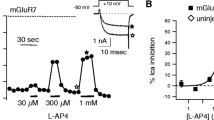Abstract
Glycine receptors (GlyRs) provide the main inhibitory neurotransmission in spinal cord and brain-stem synapses of vertebrates. Fucile et al. (2000) discovered that elevation of intracellular Ca2+ caused rapid potentiation of GlyRs. This modulation develops in less than 100 ms. It is characterized by an increase in GlyR apparent affinity for glycine. It has been suggested that the phenomenon of Ca-induced potentiation involves an unknown Ca2+-binding protein (CaBP). Using the yeast two-hybrid system, screening of a human brain cDNA library against the cytoplasmic loop of human alpha 1 subunit (GlyRh1) allowed us to identify five new interactors. One of them belongs to the family of Ca-binding proteins. We analyzed the effect of “short” forms of this protein (CaBP-1) on functional properties of GlyRh1 expressed in HEK-293 and CHO cells. Using whole-cell recordings and rapid agonist application, we constructed concentration dependences of glycine-induced currents. This analysis revealed statistically significant differences in EC50s between control cells (expressing only GlyRh1) and those expressing CaBP-1. In HEK-293 cells recorded under conditions of low intracellular Ca concentration (BAPTA 20 mM in the recording pipette), EC50 for glycine in control cells and expressing GlyRh1+CaBP-1 were, correspondingly, 68 ± 49 μM (n = 29) and 409 ± 421 μM (n = 60). In CHO cells, EC50 were 54 ± 43 μM (n = 25) and 123 ± 104 μM (n = 28). The differences were not statistically significant for recordings made with an intracellular solution containing high Ca concentration (50 μM). Under these conditions, EC50 values were correspondingly 35 ± 28 μM (n = 7) and 64 ± 38 μM (n = 7). These results suggest that CaBP-1 causes a decrease of GlyR sensitivity to agonist interacting with the cytoplasmic domain of GlyR.
Similar content being viewed by others
References
De Saint Jan, D., David-Watine, B., Korn, H., and Bregestovski, P., Activation of Human α1 and α2 Homomeric Glycine Receptors by Taurine and GABA, J. Physiol., 2001, Vol. 535, pp. 741–755.
Diana, M.A., and Bregestovski, P., Calcium and Endocannabinoids in the Modulation of Inhibitory Synaptic Transmission, Cell Calcium., 2005, Vol. 37, pp. 497–505.
Donato, R., and Nistri, A., Relative Contribution by GABA or Glycine to Cl−-mediated Synaptic Transmission on Rat Hypoglossal Motoneurons in vitro, J. Neurophysiol., 2000, Vol. 84, pp. 2715–2724.
Fields, S., and Song, O., A Novel Genetic System to Detect Protein—protein Interactions, Nature, 1989, Vol. 340, pp. 245–246.
Fucile, S., De Saint Jan, D., David-Watine, B., et al., Comparison of Glycine and GABA Actions on the Zebrafish Homomeric Glycine Receptor, J. Physiol., 1999, Vol. 517, pp. 369–383.
Fucile, S., De Saint Jan, D., Prado de Carvalho, L., and Bregestovski, P., Fast Potentiation of Glycine Receptor Channels by Intracellular Calcium in Neurons and Transfected Cell, Neuron, 2000, Vol. 28, pp. 571–583.
Grenningloh, G., Schmieden, V., Schofield, P.R., et al., Alpha Subunit Variants of the Human Glycine Receptor: Primary Structures, Functional Expression and Chromosomal Localization of the Corresponding Genes, EMBO J., 1990, Vol. 9, pp. 771–776.
Imboden, M., De Saint Jan, D., Leulier, F., et al., Isolation and Characterization of Alpha 2-type Zebrafish Glycine Receptor Subunit, Neurosci., 2001, Vol. 103, pp. 799–810.
Lynch, J.W., Molecular Structure and Function of the Glycine Receptor Chloride Channel, Physiol. Rev., 2004, Vol. 84, pp. 1051–1095.
Medina, I., Krapivinsky, G., Arnold, S., et al., A Switch Mechanism for G Beta Gamma Activation of I(KACh), J. Biol. Chem., 2000, Vol. 275, pp. 29709–29716.
Mascia, M.P., Wick, M.J., Martinez, L.D., and Harris, R.A., Enhancement of Glycine Receptor Function by Ethanol: Role of Phosphorylation, Brit. J. Pharmacol., 1998, Vol. 125, pp. 263–270.
Moorhouse, A.J., Jacques, P., Barry, P.H., and Schofield, P.R., The Startle Disease Mutation Q266H, in the Second Transmembrane Domain of the Human Glycine Receptor, Impairs Channel Gating, Mol. Pharmacol., 1999, Vol. 55, pp. 386–395.
Rhodes, A.D., Bevan, N., Patel, K., et al., Mammalian Expression of Transmembrane Receptors for Pharmaceutical Applications, Biochem. Soc. Trans., 1998, Vol. 26, pp. 699–704.
Uetz, P., Giot, L., Cagney, G., et al., A Comprehensive Analysis of Protein-protein Interactions in Saccharomyces cerevisiae, Nature, 2000, Vol. 403, pp. 623–627.
Wick, M.J., Bleck, V., Whatley, V.J., et al., Stable Expression of Human glycin α1 and α2 Homomeric Receptors in Mouse L(tk-) Cells, J. Neurosci. Meth, 1999, Vol. 87, pp. 97–103.
Author information
Authors and Affiliations
Additional information
Original Russian Text © S. Buldakova, E. Real, Y. Jacob, P. Bregestovski, 2007, published in Tsitologiya, Vol. 49, No. 1, 2007, pp. 79–82.
Rights and permissions
About this article
Cite this article
Buldakova, S., Real, E., Jacob, Y. et al. Calcium-dependent modulation of human glycine receptors expressed in cultivated cell lines. Cell Tiss. Biol. 1, 30–33 (2007). https://doi.org/10.1134/S1990519X0701004X
Received:
Issue Date:
DOI: https://doi.org/10.1134/S1990519X0701004X




